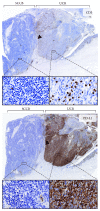Immune Exclusion Is Frequent in Small-Cell Carcinoma of the Bladder
- PMID: 31191745
- PMCID: PMC6525886
- DOI: 10.1155/2019/2532518
Immune Exclusion Is Frequent in Small-Cell Carcinoma of the Bladder
Abstract
Small-cell cancer of the urinary bladder is a rare but highly aggressive disease. It is currently unclear whether immune checkpoint therapies that have been approved for urothelial carcinomas will also be efficient in small-cell carcinomas. In this study, we analyzed potential predictors of response including PD-L1 expression and the quantity and location of tumor-infiltrating lymphocytes (TILs) in 12 small-cell and 69 "classical" urothelial cancers by immunohistochemistry. The analysis revealed that small-cell carcinomas were characterized by the virtual absence of PD-L1 expression and an "immune-excluded" phenotype with only a few TILs in the center of the tumor (CT). In small-cell carcinomas, the average immune cell density in the CT (CD3: 159 ± 206, CD8: 87 ± 169 cells/mm2) was more than 3 times lower than that in the urothelial carcinomas (CD3: 625 ± 800, p < 0.001; CD8: 362 ± 626 cells/mm2, p = 0.004) while there was no significant difference in the immune cell density at the invasive margin (IM) (small-cell carcinomas CD3: 899 ± 733, CD8: 404 ± 433 cells/mm2; urothelial carcinomas CD3: 1167 ± 1206, p = 0.31; CD8: 582 ± 864 cells/mm2, p = 0.27). Positive PD-L1 staining was found in 39% of urothelial cancers, but in only 8% of small-cell bladder cancer cases (p = 0.04). Concordant with these data, a sharp decrease of PD-L1 positivity from >80% to 0% positive cells and of TILS in the CT from 466-1063 CD3-positive cells/mm2 to 50-109 CD3-positive cells/mm2 was observed in two cancers with clear-cut progression from "classical" urothelial to small-cell carcinoma. In conclusion, these data demonstrate that small-cell bladder cancer commonly exhibits an immune-excluded phenotype.
Figures



References
-
- Wilde L., Ali S. M., Solomides C. C., Ross J. S., Trabulsi E., Hoffman-Censits J. Response to pembrolizumab in a patient with chemotherapy refractory bladder cancer with small cell variant histology: a case report and review of the literature. Clinical Genitourinary Cancer. 2017;15(3):e521–e524. doi: 10.1016/j.clgc.2016.12.012. - DOI - PubMed
MeSH terms
Substances
LinkOut - more resources
Full Text Sources
Medical
Research Materials

